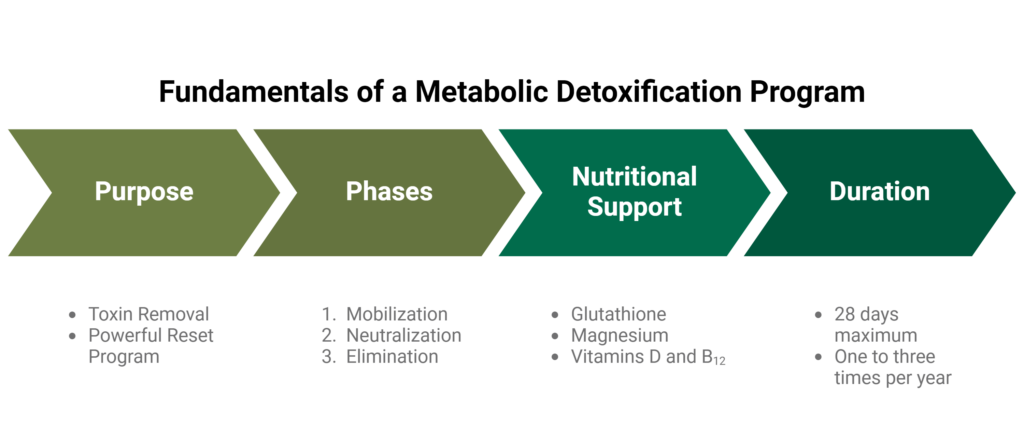Detox vs. Cleanse vs. Purification
Understanding detox vs. cleanse vs. purification and selecting the right “reset” program for the right patient can be difficult with all of the nomenclature used to describe various nutritional approaches. What is truly the difference between metabolic detoxification support, purification, and cleansing? Which is the best option for a patient looking to hit the “reset” button?
Three Tiers of Targeted Approach: Detox vs. Cleanse vs. Purification
Consider the differences between these three reset programs as a tiered approach to wellness maintenance.
- Cleanse: The patient and health care practitioner (HCP) discuss the potential need for addressing gastrointestinal (GI) function. Some questions the HCP may want to ask the patient include whether there are existing GI disorders and if the patient wants to “clean out” their gut. A cleansing reset program might simply aim to prevent or decrease toxin exposure and absorption.
- Purification: The patient and HCP discuss a potential problem with toxins circulating in the bloodstream. The patient prompts toxin removal through sweating, increased hydration, and healthy nutrition choices as part of the purification process.
- Metabolic Detoxification Support: The patient and HCP discuss the more complex situation of both circulating toxins and toxins stored within the body’s cells, mainly fat cells. A more powerful reset program is needed for proper stored toxin removal, and it includes activating the three phases of the body’s natural detoxification process.

Image created with BioRender.com
The Problem with Stored Toxins
Stored toxins are not in hibernation; they can inhibit cellular function, and they need to be removed. The presence of toxins stored in the body’s cells, not just circulating in the bloodstream, requires a robust reset program: metabolic detoxification support. Unlike circulating toxins, stored toxins first need to be mobilized (1), then neutralized (2) and eliminated (3). These three phases of the detoxification process require nutritional support to be successful.
How the Body Naturally Detoxifies
Metabolic detoxification occurs through a three-step process. Unlike circulating toxins, stored toxins first need to be mobilized. The mobilization of toxins is technically referred to as bioactivation. In this step, enzymes add a reactive group to the toxin, producing an activated toxin that is often more reactive and dangerous than the initial toxin.
In the next step, activated toxins are conjugated to water-soluble molecules that allow for the last step, elimination. Together, these three steps support healthy detoxification processes and overall human health.
Why a Patient Might Need a Detox
There are many reasons to undergo a metabolic detoxification program. Patients with a high toxic load may benefit from a detox due to easily identifiable factors like:
- Living in a heavily polluted area
- Chronic, consistent exposure to environmental toxicants
- A history of smoking or heavy and consistent alcohol consumption
- Prolonged use of certain prescription medications, especially those that are metabolized by the liver
- Consuming diets high in processed foods, refined sugars, unhealthy fats, and artificial additives
Symptoms and health conditions may also point to an issue with toxin load. A patient may need to undergo a detoxification protocol if they are experiencing symptoms such as:
- Fatigue
- Difficulty sleeping
- Weight gain
- Food cravings
- GI issues, low libido
- Skin issues
- Reduced mental clarity
Eventually, improper clearance of toxins can lead to serious issues in the body, potentially contributing to obesity, cardiovascular disease, immune dysfunction, and reproductive concerns.
Nutritional Support During Detox
Nutritional support during detoxification will reduce the risk of side effects that can occur when stored toxins are mobilized during phase I and moved to the circulation. Without proper nutritional support, detoxification can do more harm than good. Metabolic detoxification support needs to be well-planned; a patient needs to be prepared for a successful detoxification with adequate nutrition, particularly for the neutralization of mobilized toxins during phase II.
The Key Components of a Detox Formula & Nutrition Protocol
Stored toxins are activated and mobilized by phase I enzymes before phase II enzymes can recognize them, tag them with a conjugating molecule, and neutralize them. Phase II is arguably the most important phase of detoxification because of its nutritional support requirements. Patients preparing for a detox should have adequate levels of:
- Amino acids
- Magnesium
- Glutathione
- Vitamin D and B12
It is also important to address any methylation deficiency prior to beginning metabolic detoxification support. A methyl group is required as a cofactor for conjugation in phase II. It is difficult to address methylation deficiency during a detoxification program and should instead be done in preparation.
Throughout the detoxification process, a formulation supportive of the three phases might include:
- Vitamin D, vitamin B12, and magnesium for phase II stored toxin mobilization
- Amino acid support for phases I and II
- Glutathione support
- Methylation support
- ATP (energy) support via creatine
Common Misconceptions about Detoxification
For many people, the word “detoxification” may equate to a restrictive diet or drinking only juice for three days. However, the body’s natural detoxification process is much more complex than one prescribed “detox diet”.
First, detoxification is not an elimination diet. Elimination diets are designed to identify foods that may exacerbate an immune or inflammatory response in the body.
Similarly, detoxification is not simply following a restrictive or liquid diet. While these types of programs may help limit toxin exposure overall, they fail to provide the essential vitamins, minerals, and whole-food support that promote healthy detoxification processes.
Finally, detoxification programs cannot be accomplished in a matter of hours or days. The body needs time to effectively get rid of toxins.
How Long Should A Metabolic Detox Support Program Last?
A baseline detoxification process occurs regularly in the body. Metabolic detoxification support formulations push activity above baseline detoxification to specifically target and remove stored toxins. Pushing the body above baseline detox activity should not be done for too long or too often to prevent nutrient depletion and risk of side effects: no more than 28 days at a time and no more than once to three times per year.
Formulations can be used beyond the 28-day limit if the therapeutic ingredients are used at a dosage that supports baseline detoxification. Depending on what a patient’s main goal is, detox formulations can either support baseline activity as a pre-/post-detox or support a robust, temporary detoxification process.
Clinical evidence can showcase the positive effects of metabolic detoxification support programs through biomarkers that note the toxin elimination. A healthcare practitioner can support their patients in making the best decision based on health needs and accurately showcase this through pre- and post-clinical assessments.
Potential Benefits of Detoxification
While it may take a few days for the body to adjust to a detoxification support program, once it does, the body should begin to feel much better. Some people may notice they are sleeping better or craving less unhealthy foods, thinking more clearly, and feeling relief in previously painful joints. While weight loss is not the goal of detoxification, it commonly occurs as a natural side effect of improved eating and decreased toxin load.
Additionally, clinical evidence can showcase the positive effects of metabolic detoxification support programs through biomarkers that note toxin elimination.
Conclusion
In navigating the landscape of detox, cleanse, and purification programs, selecting the appropriate reset for a patient’s health needs can be a challenge given the array of options and terminology. Understanding the nuanced differences between metabolic detoxification support, purification programs, and cleansing initiatives is essential for tailoring interventions that will successfully impact each patient.
Each program requires a unique approach to wellness maintenance, addressing varying levels of toxin exposure and elimination pathways within the body. As we delve into the complexities of detoxification, it becomes clear that a targeted approach is key to address stored toxins effectively.
By incorporating nutritional support tailored to the body’s natural detoxification phases, the journey towards improved health and vitality becomes clearer for patients. Ultimately, the goal of these programs extends beyond just alleviating symptom to promote overall well-being and making healthier choices.
With proper guidance from healthcare practitioners and a comprehensive understanding of detoxification processes, individuals can enjoy the health benefits these programs can provide and embark on a path towards optimal health.
Did you know Wholistic Matters is powered by Standard Process? Learn more about healthcare practitioner benefits.







